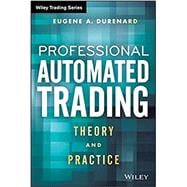Reflecting author Eugene Durenard's extensive experience in this field, Professional Automated Trading offers valuable insights you won't find anywhere else. It reveals how a series of concepts and techniques coming from current research in artificial life and modern control theory can be applied to the design of effective trading systems that outperform the majority of published trading systems. It also skillfully provides you with essential information on the practical coding and implementation of a scalable systematic trading architecture.
Based on years of practical experience in building successful research and infrastructure processes for purpose of trading at several frequencies, this book is designed to be a comprehensive guide for understanding the theory of design and the practice of implementation of an automated systematic trading process at an institutional scale.
- Discusses several classical strategies and covers the design of efficient simulation engines for back and forward testing
- Provides insights on effectively implementing a series of distributed processes that should form the core of a robust and fault-tolerant automated systematic trading architecture
- Addresses trade execution optimization by studying market-pressure models and minimization of costs via applications of execution algorithms
- Introduces a series of novel concepts from artificial life and modern control theory that enhance robustness of the systematic decision making—focusing on various aspects of adaptation and dynamic optimal model choice
Engaging and informative, Proprietary Automated Trading covers the most important aspects of this endeavor and will put you in a better position to excel at it.








